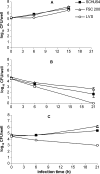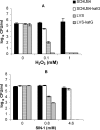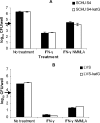Resistance of Francisella tularensis strains against reactive nitrogen and oxygen species with special reference to the role of KatG
- PMID: 17210667
- PMCID: PMC1828546
- DOI: 10.1128/IAI.01717-06
Resistance of Francisella tularensis strains against reactive nitrogen and oxygen species with special reference to the role of KatG
Abstract
Francisella tularensis is a facultative intracellular bacterial pathogen capable of proliferating within host macrophages. The mechanisms that explain the differences in virulence between various strains of the species are not well characterized. In the present study, we show that both attenuated (strain LVS) and virulent (strains FSC200 and SCHU S4) strains of the pathogen replicate at similar rates in resting murine peritoneal exudate cells (PEC). However, when PEC were activated by exposure to gamma interferon (IFN-gamma), they killed LVS more rapidly than virulent strains of the pathogen. Addition of N(G)-monomethyl-l-arginine, an inhibitor of inducible nitric oxide synthase, to IFN-gamma-treated PEC, completely inhibited killing of the virulent strains, whereas it only partially blocked the killing of LVS. Similarly, in a cell-free system, SCHU S4 and FSC200 were more resistant to killing by H(2)O(2) and ONOO(-) than F. tularensis LVS. Catalase encoded by katG is a bacterial factor that can detoxify bactericidal compounds such as H(2)O(2) and ONOO(-). To investigate its contribution to the virulence of F. tularensis, katG deletion-containing mutants of SCHU S4 and LVS were generated. Both mutants demonstrated enhanced susceptibility to H(2)O(2) in vitro but replicated as effectively as the parental strains in unstimulated PEC. In mice, LVS-DeltakatG was significantly attenuated compared to LVS whereas SCHU S4-DeltakatG, despite slower replication, killed mice as quickly as SCHU S4. This implies that clinical strains of the pathogen have katG-independent mechanisms to combat the antimicrobial effects exerted by H(2)O(2) and ONOO(-), the loss of which could have contributed to the attenuation of LVS.
Figures




Similar articles
-
The contribution of reactive nitrogen and oxygen species to the killing of Francisella tularensis LVS by murine macrophages.Microbes Infect. 2005 Mar;7(3):467-75. doi: 10.1016/j.micinf.2004.11.020. Epub 2005 Feb 26. Microbes Infect. 2005. PMID: 15788155
-
Roles of reactive oxygen species-degrading enzymes of Francisella tularensis SCHU S4.Infect Immun. 2015 Jun;83(6):2255-63. doi: 10.1128/IAI.02488-14. Epub 2015 Mar 23. Infect Immun. 2015. PMID: 25802058 Free PMC article.
-
Control of Francisella tularensis Intracellular Growth by Pulmonary Epithelial Cells.PLoS One. 2015 Sep 17;10(9):e0138565. doi: 10.1371/journal.pone.0138565. eCollection 2015. PLoS One. 2015. PMID: 26379269 Free PMC article.
-
Impact of Francisella tularensis pilin homologs on pilus formation and virulence.Microb Pathog. 2011 Sep;51(3):110-20. doi: 10.1016/j.micpath.2011.05.001. Epub 2011 May 13. Microb Pathog. 2011. PMID: 21605655 Free PMC article.
-
Adherence and uptake of Francisella into host cells.Virulence. 2013 Nov 15;4(8):826-32. doi: 10.4161/viru.25629. Epub 2013 Jul 10. Virulence. 2013. PMID: 23921460 Free PMC article. Review.
Cited by
-
A mucosal subunit vaccine protects against lethal respiratory infection with Francisella tularensis LVS.PLoS One. 2012;7(11):e50460. doi: 10.1371/journal.pone.0050460. Epub 2012 Nov 28. PLoS One. 2012. PMID: 23209745 Free PMC article.
-
Subversion of host recognition and defense systems by Francisella spp.Microbiol Mol Biol Rev. 2012 Jun;76(2):383-404. doi: 10.1128/MMBR.05027-11. Microbiol Mol Biol Rev. 2012. PMID: 22688817 Free PMC article. Review.
-
Immunity to Francisella.Front Microbiol. 2011 Feb 16;2:26. doi: 10.3389/fmicb.2011.00026. eCollection 2011. Front Microbiol. 2011. PMID: 21687418 Free PMC article.
-
From the Outside-In: The Francisella tularensis Envelope and Virulence.Front Cell Infect Microbiol. 2015 Dec 23;5:94. doi: 10.3389/fcimb.2015.00094. eCollection 2015. Front Cell Infect Microbiol. 2015. PMID: 26779445 Free PMC article. Review.
-
Francisella tularensis Catalase Restricts Immune Function by Impairing TRPM2 Channel Activity.J Biol Chem. 2016 Feb 19;291(8):3871-81. doi: 10.1074/jbc.M115.706879. Epub 2015 Dec 17. J Biol Chem. 2016. PMID: 26679996 Free PMC article.
References
-
- Bakshi, C. S., M. Malik, K. Regan, J. A. Melendez, D. W. Metzger, V. M. Pavlov, and T. J. Sellati. 2006. Superoxide dismutase B gene (sodB)-deficient mutants of Francisella tularensis demonstrate hypersensitivity to oxidative stress and attenuated virulence. J. Bacteriol. 188:6443-6448. - PMC - PubMed
-
- Bryk, R., P. Griffin, and C. Nathan. 2000. Peroxynitrite reductase activity of bacterial peroxiredoxins. Nature 407:211-215. - PubMed
-
- Carmel-Harel, O., and G. Storz. 2000. Roles of the glutathione- and thioredoxin-dependent reduction systems in the Escherichia coli and Saccharomyces cerevisiae responses to oxidative stress. Annu. Rev. Microbiol. 54:439-461. - PubMed
-
- Chen, W., R. KuoLee, H. Shen, and J. W. Conlan. 2004. Susceptibility of immunodeficient mice to aerosol and systemic infection with virulent strains of Francisella tularensis. Microb. Pathog. 36:311-318. - PubMed
Publication types
MeSH terms
Substances
Grants and funding
LinkOut - more resources
Full Text Sources
Other Literature Sources

